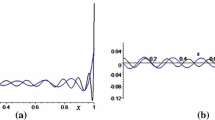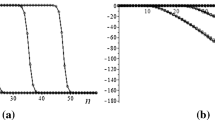Abstract
We introduce a family of generalized prolate spheroidal wave functions (PSWFs) of order \(-1,\) and develop new spectral schemes for second-order boundary value problems. Our technique differs from the differentiation approach based on PSWFs of order zero in Kong and Rokhlin (Appl Comput Harmon Anal 33(2):226–260, 2012); in particular, our orthogonal basis can naturally include homogeneous boundary conditions without the re-orthogonalization of Kong and Rokhlin (2012). More notably, it leads to diagonal systems or direct “explicit” solutions to 1D Helmholtz problems in various situations. Using a rule optimally pairing the bandwidth parameter and the number of basis functions as in Kong and Rokhlin (2012), we demonstrate that the new method significantly outperforms the Legendre spectral method in approximating highly oscillatory solutions. We also conduct a rigorous error analysis of this new scheme. The idea and analysis can be extended to generalized PSWFs of negative integer order for higher-order boundary value and eigenvalue problems.






Similar content being viewed by others
References
Abramowitz, M., Stegun, I.A.: Handbook of Mathematical Functions. Dover, New York (1972)
Al-Gwaiz, M.A.: Sturm–Liouville Theory and Its Applications. Springer, Berlin (2008)
Arfken, G.B., Weber, H.J.: Mathematical Methods for Physicists. Harcourt/Academic Press, San Diego (2001)
Babuška, I., Sauter, S.A.: Is the pollution effect of the FEM avoidable for the Helmholtze equation considering high wave number? SIAM Rev. 34(6), 2392–2423 (1997)
Bouwkamp, C.J.: On the theory of spheroidal wave functions of order zero. Ned. Akad. Wetensch. Proc. 53, 931–944 (1950)
Boyd, J.P.: Large mode number eigenvalues of the prolate spheroidal differential equation. Appl. Math. Comput. 145(2), 881–886 (2003)
Boyd, J.P., Gassner, G., Sadiq, B.A.: The nonconvergence of \(h\)-refinement in prolate elements. J. Sci. Comput. 57(2), 372–389 (2013)
Coddington, E.A., Levinson, N.: Theory of Ordinary Differential Equations. McGraw-Hill, New York (1955)
Guo, B.Y., Shen, J., Wang, L.L.: Optimal spectral-Galerkin methods using generalized Jacobi polynomials. J. Sci. Comput. 27(1), 305–322 (2006)
Hogan, J.A., Lakey, J.D.: Duration and Bandwidth Limiting: Prolate Functions, Sampling, and Applications. Birkhäuser, New York (2012)
Bonami, A., Karoui, A.: Spectral decay of time and frequency limiting operator. Appl. Comput. Harmon. Anal. (2015). doi:10.1016/j.acha.2015.05.003.2015
Karoui, A., Souabni, A.: Generalized prolate spheroidal wave functions: spectral analysis and approximation of almost band-limited functions. J. Fourier Anal. Appl. 22(2), 383–412 (2016)
Kong, W.Y., Rokhlin, V.: A new class of highly accurate differentiation schemes based on the prolate spheroidal wave functions. Appl. Comput. Harmon. Anal. 33(2), 226–260 (2012)
Osipov, A., Rokhlin, V., Xiao, H.: Prolate Spheroidal Wave Functions of Order Zero. Springer, Berlin (2013)
Shen, J., Tang, T., Wang, L.L.: Spectral Methods: Algorithms, Analysis and Applications. Springer, Berlin (2011)
Shen, J., Wang, L.L.: Spectral approximation of the Helmholtz equation with high wave numbers. SIAM J. Numer. Anal. 43(2), 623–644 (2005)
Slepian, D.: Prolate spheroidal wave functions, Fourier analysis and uncertainity. IV. Bell Syst. Tech. J. 43(6), 3009–3057 (1964)
Slepian, D.: Some comments on Fourier analysis, uncertainty and modeling. SIAM Rev. 25(3), 379–393 (1983)
Slepian, D., Pollak, H.O.: Prolate spheroidal wave functions, Fourier analysis and uncertainty. I. Bell Syst. Tech. J. 40, 43–63 (1961)
Szegö, G.: Orthogonal Polynomials, 4th edn. AMS Colloquium Publications, Providence (1975)
Wang, K., Wong, Y.S., Deng, J.: Efficient and accurate numerical solutions for Helmholtz equation in polar and spherical coordinates. Commun. Comput. Phys. 17(3), 779–807 (2015)
Wang, L.L., Samson, M.D., Zhao, X.D.: A well-conditioned collocation method using a pseudospectral integration matrix. SIAM J. Sci. Comput. 36(3), 907–929 (2014)
Wang, L.L., Zhang, J.: A new generalization of the PSWFs with applications to spectral approximations on quasi-uniform grids. Appl. Comput. Harmon. Anal. 29(3), 525–545 (2010)
Wang, L.L., Zhang, J., Zhang, Z.: On hp-convergence of prolate spheroidal wave functions and a new well-conditioned prolate-collocation scheme. J. Comput. Phys. 268(2), 377–398 (2014)
Weideman, J.A.C., Trefethen, L.N.: The eigenvalues of second-order spectral differentiation matrices. SIAM J. Numer. Anal. 25(6), 1279–1298 (1988)
Xiao, H., Rokhlin, V., Yarvin, N.: Prolate spheroidal wavefunctions, quadrature and interpolation. Inverse Probl. 17(4), 805–838 (2001)
Zhang, Z.: How many numerical eigenvalues can we trust? J. Sci. Comput. 65(2), 1–12 (2015)
Zhao, X.D., Wang, L.L., Xie, Z.Q.: Sharp error bounds for Jacobi expansions and Gegenbauer–Gauss quadrature of analytic functions. SIAM J. Numer. Anal. 51(3), 1443–1469 (2013)
Author information
Authors and Affiliations
Corresponding author
Additional information
Jing Zhang: The work of this author is partially supported by the National Natural Science Foundation of China (11201166), and the Fundamental Research Funds for the Central Universities (CCNU15A02033).
Li-Lian Wang: The research of this author is partially supported by Singapore MOE AcRF Tier 1 Grants (RG 15/12 and 27/15), and Singapore MOE AcRF Tier 2 Grant (MOE 2013-T2-1-095, ARC 44/13).
Huiyuan Li: The research of this author is partially supported by the National Natural Science Foundation of China (91130014, 11471312 and 91430216).
Zhimin Zhang: The research of this author is supported in part by the National Natural Science Foundation of China (11471031 and 91430216), and the U.S. National Science Foundation (DMS-1419040). The first author would like to thank the supports from both Beijing Computational Sciences and Research Center, Beijing, China and Division of Mathematical Sciences of Nanyang Technological University, Singapore.
Appendix 1: Proof of Lemma 4.1
Appendix 1: Proof of Lemma 4.1
We first recall the following bound in [12, Appendix].
Proposition 4.1
Let \(q_n\) be defined as in (4.1). If \(q_n\le 1\), then for all positive integer k such that \(k(k+3)\le \chi _n^{(1)}(c)\) and \(n+k\) is even, we have
Note that if \(n+k\) is odd, then \(\partial _x^k\psi _n^{(1)}(0)=0.\)
Proposition 4.2
Let \(\{\beta _k^n\}\) be defined in (2.16). For given \(c>0\) and \(n\in {\mathbb N},\) let
We have
-
(i)
If both n and k are even, then \(\beta _{0}^n, \beta _2^n, \beta _4^n,\ldots \) have the same sign, and \(|\beta _k^n|\le |\beta _{k+2}^n|\) for all \(k=0,2,4,\ldots ,\) satisfying (4.27);
-
(ii)
If both n and k are odd, then \(\beta _{1}^n, \beta _3^n, \beta _5^n,\ldots \) have the same sign, and \(|\beta _k^n|\le |\beta _{k+2}^n|\) for all \(k=1,3,5,\ldots ,\) satisfying (4.27).
Note that if \(n+k\) is odd, then \(\beta _{k}^n=0.\)
Proof
From (2.16) and the parity of \(\psi _n^{(1)}(x)\) and \(P_k^{(1)}(x),\) we have \(\beta _{k}^n=0,\) if \(n+k\) is odd.
We first justify the statement (i). By (2.18),
with \(\beta _{-2}^n=\beta _{-1}^n=0\), where
One verifies that for \(k\ge 2\),
and for \(k\ge 1,\)
We proceed with the proof by induction. For \(k=0\), we find from (4.28) that
It is evident that with a looser condition than (4.27), the factor in front of \(\beta _{0}^n\) is positive, so \(\beta _2^n\) has the same sign as \(\beta _0^n.\) Moreover, by (4.27) with \(k=0,\)
We next assume that \(\beta _{k-2}^n\beta _k^n>0\) and \(|\beta _{k-2}^n|\le |\beta _k^n|\) for all \(k\ge 2.\) Then we derive from (4.28), (4.30)–(4.31) and (4.27) that
which implies \(\beta _{k+2}^n\,\beta _k^n>0.\) Now, we show that \(|\beta _{k}^n|\le |\beta _{k+2}^n|\). We show this by contradiction. Assuming that \(|\beta _{k}^n|>|\beta _{k+2}^n|,\) we find from (4.34) and (4.30) that
which contradicts to (4.27). Thus, we have \(|\beta _{k}^n|\le |\beta _{k+2}^n|\) for even n and k.
The statement (ii) can be justified similarly. In fact, the derivations in (4.34)–(4.35) also hold for odd n, k, so it suffices to verify the initial of the induction. Like (4.32)–(4.33), we can show that
and
which implies \(\beta _3^n\) has the same sign as \(\beta _1^n\), and \(|\beta _1^n|\le |\beta _3^n|.\) Then, we use (4.34)–(4.35) to complete the proof of Proposition A.2.\(\square \)
Proof of Lemma 4.1
With the above propositions, we are now ready to prove Lemma 4.1. \(\square \)
The bound for \(\beta _0^n\) follows directly from (2.23) and (4.26) with \(k=0.\)
We carry out the proof by estimating the moment: \(\int _{-1}^1t^m\psi _n^{(1)}(t)\omega _1(t)dt.\) Note that
where we can find the formula of \(\hat{p}_{jk}\) from [12, (16)-(17)], and have
Thus, we obtain from (2.16) that
where we used the property: \(\beta _k^n=0\), if \(k+n\) is odd.
On the other hand, taking the jth derivative at \(x=0\) on both sides of (2.8) with \(\alpha =1\), yields
which vanishes, if \(j+n\) is odd.
Thus, we have from Lemma A.2 (i), and (4.37)–(4.39) that for even n, j,
and further by (4.26),
Similarly, for odd n, j,
Thus, by (4.37), and (4.3)–(4.4),
Then we obtain the bound (4.2).
Rights and permissions
About this article
Cite this article
Zhang, J., Wang, LL., Li, H. et al. Optimal Spectral Schemes Based on Generalized Prolate Spheroidal Wave Functions of Order \(-1\) . J Sci Comput 70, 451–477 (2017). https://doi.org/10.1007/s10915-016-0253-2
Received:
Revised:
Accepted:
Published:
Issue Date:
DOI: https://doi.org/10.1007/s10915-016-0253-2
Keywords
- Generalized prolate spheroidal wave functions of order \(-1\)
- Helmholtz equations
- Optimal spectral schemes
- Error analysis




